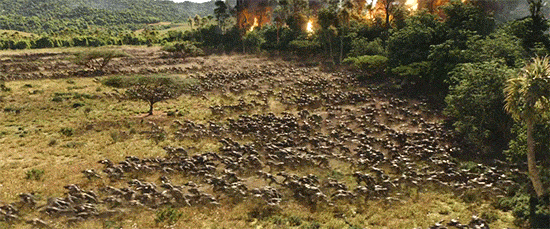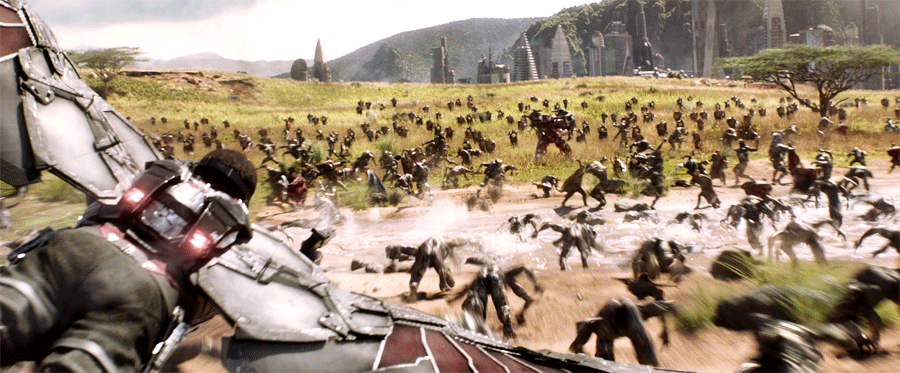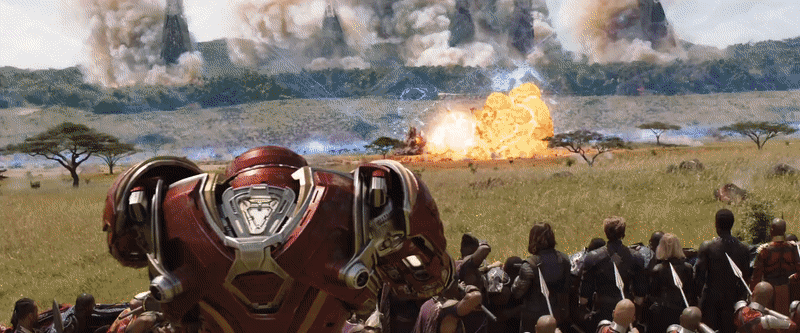One of the many action sequences of Avengers: Infinity War was the siege on Wakanda. Thanos–on his quest for the Infinity stones–tracks Vision to Wakanda in order to extract the Soul Stone from his forehead. He sends his Black Order–plus a seemingly unending number of alien servants called Outriders–to take Wakanda, and their formidable defense in the Dora Milaje and a force dome that covered the capital. Plus, the Avengers were present to hold the line.
Confronted with the force dome, the Black Order released the Outriders, hoping to overwhelm it through sheer ferocity and numbers. Movie goers watched the Outriders sprint toward the Avengers and Dora Milaje, War Machine’s gatling fire sizzling past them. The Outriders snarled their teeth as they continued to charge, undeterred that many of the numbers were being gunned down.
 The Outriders wouldn’t kill anyone—that wasn’t the point. Their ferocity was meant to force the Avengers to scatter and break formation for a moment, buying the Black Order a brief second to sneak behind enemy lines.
The Outriders wouldn’t kill anyone—that wasn’t the point. Their ferocity was meant to force the Avengers to scatter and break formation for a moment, buying the Black Order a brief second to sneak behind enemy lines.
A single Outrider’s glorious charge might last only three seconds before a Dora Milaje blade would spin around and slice into its side. But in doing so, their attention is drawn toward a single foe, as hordes and hordes more battered their lines. As hundreds of Outriders lay dead in the savannah grass of Wakanda, the Black Order grinds forward a few yards, while many more Outriders line up behind, just to do what others just did.
To Thanos, life is cheap. Yet he wasn’t the first one to utilize this tactic. It’s called a Human Wave Attack and it’s been utilized throughout history. It’s an offensive infantry tactic that bombards an enemy’s front lines with seemingly never-ending ground troops who rush in wholly unprotected.
A human wave attack is meant to quickly advance as many troops as possible into close range, hoping that the shock from a large swarm of attackers engaged in melee combat will force the enemy to fall back into disarray. The organization and the training of the attacking wave is irrelevant–they’re cannon fodder. It simply requires either courage or coercion for the attackers to advance into enemy fire.
If attackers are matched against modern weaponry such as automatic firearms, artillery, or air support, a human wave attack is an extremely dangerous and costly tactic. But what does Thanos care? His plan was to snap 50% of them out of existence anyway.

Remember, human wave attacks aren’t just something out of comic books, they’re a significant part of human history. Farmers armed seemingly with not much more than pitchforks rushing at British infantry as they hastily reloaded their muskets during the American Revolutionary War comes to mind, as does the Boxer Rebellion.
In fact, Thanos’ utter disregard for life could have been lifted straight from the history books, not from a comic panel. The last skirmish of World War I–Armistice Day–saw 10,000 casualties. Despite a cease fire scheduled at 11am on November 11th, 1918, General John Pershing was still ordering his American troops to advance, even as the people of Paris, London, and New York were celebrating the end of the war.
The Americans took heavy casualties, all because Pershing believed that the Germans had to be severely defeated at a military level to effectively ‘teach them a lesson.’ Private Henry Gunter was killed at 10:59, one minute before the scheduled end of the war, having been ordered to advance and take a German machine gun post. History tells us that the Germans – who, like Pershing, knew they were literally minutes away from a ceasefire – tried to signal the Americans to stop attacking. But when it became obvious that this had failed, they fired on their attackers and Gunter was killed.
When life is seen as cheap, one can only be left with regret. Pity the poor Outriders, genetically bred by Thanos to serve merely as compliant cannon fodder. Pity the poor Avengers, forced into a fight they didn’t ask for. And pity poor Thanos, so twisted in his morality that none of the life in the universe means anything to him, right down to using the the tactic of throwing lives at the Avengers in a ferocious wave.
Eh, but it’s just a comic book movie, even if it is a record-setting one. And you may be rolling your eyes at the mention of tactics in a Human Wave Attack—and for good reason. After all, this article began with a description of running headlong and recklessly into enemy fire. But it does have identifiable tactics, though clumsy and improvisational ones.

A human wave attack encourages attackers to push, to try and mob control points, and to overwhelm the enemy. It’s a sort of follow-the-leader mentality like you find in “Capture the Flag” style FPS games. The objective, to paraphrase Stalin, is to make the enemy choke on your dead.
But dismissing this mad rush as unstrategic misunderstands its nuance. These wave attacks operate by overwhelming the enemy, both literally and visually. When presented with multiple targets, defenders tend to focus fire on the most obvious few, letting the majority get closer.
These loud, obvious frontal attacks also make flanking moves extremely effective. Thankfully, the Avengers recognized this when the Outriders began to circle the dome. Rather than allow themselves to be flanked, the Avengers ordered a narrow opening in the dome, thereby creating a chokepoint. Although it allowed the Outriders to pour into the dome, it also contained and grouped them, allowing the Avengers to unleash AoE attacks.
Human wave warfare tactics work on collective effort rather than individual heroism. Killing the enemy wasn’t the goal of an individual Outrider, it was to soak up fire. And every Outrider helped with that, even if just for a few seconds. Apart from the occasional spectacular moment rendered as glorious action sequences for the big screen, it’s a high-casualty grind—one where small sacrifices add up to victory. There is little heroism to be found in human wave attacks because a soldier’s role is always a brief one.
Which, in the cruel warfare of Thanos, is exactly as it should be.

